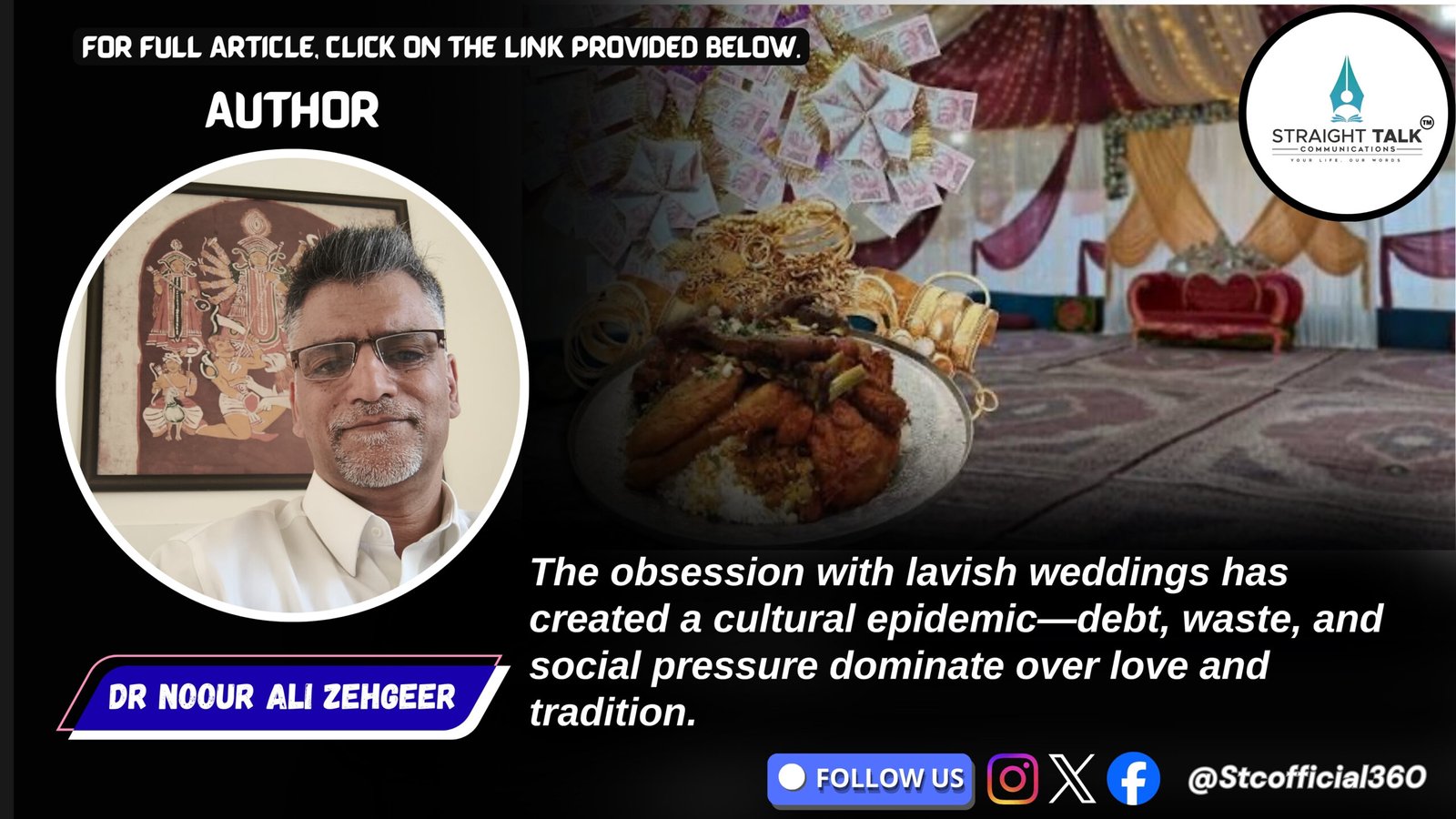Kashmir’s Wedding Olympics: When Matrimony Turns Into a Money Marathon”

The obsession with lavish weddings has created a cultural epidemic—debt, waste, and social pressure dominate over love and tradition.
Dr Noour Ali Zehgeer
To perform a Sunnah you just needed few well-wishers and some dates to distribute after Nikah in old days. Daughter was never considered as biddat as it was easy to find a groom and perform Nikah. The New world especially Kashmiri Society has made it so expensive, thus unaffordable for lower middle class or poor people to get their daughters married.
Step into the world of Kashmiri weddings, where the simple act of getting married has become an expensive competition of prestige, display, and culinary excess. The joy of union seems lost behind mountains of nuts, endless wazwan platters, and extravagant demands that leave families bankrupt before the newlyweds even leave the hall.
The modern times Muslim Marriage in Kashmir reminds me of only one thing that is we have not come out of our Inferiority Complex.
Take, for example, a recent wedding in Srinagar’s downtown. The groom’s family had lined up dry fruit trays as if preparing for the Olympics—pistachios, almonds, cashews, all arranged in ornate boxes worth thousands of rupees. Cameras flashed as relatives posed with the trays. Once the nuts were eaten, the boxes were discarded, forgotten, and left to gather dust—a symbol of social vanity masquerading as tradition.
Kashmiri weddings have evolved into contests of wealth display. The focus is no longer on love or companionship but on how many sheep can be slaughtered, how many guests can be stuffed into banquet halls, and how many dishes can be piled on a plate only to be wasted. In some weddings, over twenty dishes are served per guest, from mutton rogan josh to Tabak maaz, much of it discarded while impoverished neighbours wait outside, turned away. A simple meal of rice and curry would suffice, but simplicity rarely earns social applause—or viral reels on social media.
Marriage Expenses have become unaffordable for lower Middles class who neither belong to Business fretarnity neither are service class who can opt for loans basis on their income
Religion, ironically, teaches the opposite. The Prophet Muhammad (peace be upon him) emphasized compassion and simplicity. He never instructed families to bankrupt themselves for lavish feasts, and he certainly did not encourage turning away the needy with anger. In Islam, the only required feast is the Walima, hosted by the groom. The bride’s family is not mandated to organize costly ceremonies or “special feasts” for scores of invited guests. Historical records show that the Prophet married more than once, yet no chronicler mentions extravagant bride-side events or lavish gift exchanges that could ruin a household.
Despite these teachings, modern practices have created a financial nightmare. Consider the example of a young couple from Baramulla. The groom’s family spent over Rs 10 lakh on a three-day wedding, including elaborate decoration, designer outfits, and imported dry fruits. Meanwhile, the bride’s family had to rent additional halls and hire extra staff to accommodate “expected” guests. Both families ended up taking loans, and the couple postponed setting up their home for months because of the mounting debts. These practices make marriage a luxury rather than a natural step in life.
Meanwhile, biology waits for no one. Hormones, puberty, and desire are natural, and Islam provides Nikah as a lawful and accessible outlet. But when marriages are pushed beyond financial reach, youth are left frustrated, and some are driven toward risky or socially frowned-upon alternatives. For instance, surveys indicate that 27.1% of Indian men and 19.9% of women remained unmarried in 2021, up from 13.5% and 19% respectively in 2011. In Kashmir, the problem is compounded by unemployment, career uncertainties, and societal expectations around lavish weddings. Young men and women, despite being ready for marriage biologically, are benched indefinitely because of financial constraints.
Even the social media era exacerbates the problem. Weddings are no longer private celebrations—they are content for Instagram reels, YouTube highlights, and TikTok-like videos. Families spend lakhs on photography, videography, and themed décor, seeking likes and applause rather than celebrating the union itself. A friend of mine shared a story of a wedding where the groom’s family hired a professional drone operator, light designer, and choreographer to ensure the entrance of the bride looked cinematic. Meanwhile, a simple plate of biryani for the local poor would have sufficed for tradition—but it didn’t make the highlight reel.
The solution is surprisingly simple: return to the basics. Nikah was never meant to be a showcase of wealth; it was designed to protect youth, provide a lawful outlet for desire, and unite families. Complicated ceremonies, multi-day feasts, and designer gifts are innovations that have transformed marriage from a sacred contract into a social burden. Communities should encourage simple Nikahs, where costs are minimal, and the focus remains on companionship, not competition.
Examples of alternatives already exist. In some parts of Kashmir, NGOs and community groups have begun promoting low-cost weddings, with a simple Nikah ceremony followed by a modest Walima. Families are encouraged to donate surplus food to the needy rather than waste it on elaborate buffets. A wedding in Kupwara last year hosted just 50 close relatives, served a few local dishes, and still became memorable for its warmth rather than extravagance. Such models prove that celebration does not require bankruptcy.
In conclusion, Kashmir is at a crossroads. The obsession with lavish weddings has created a cultural epidemic—debt, waste, and social pressure dominate over love and tradition. Until families, society, and youth reclaim simplicity, marriage will remain a financial marathon rather than a joyful union. The Wedding Olympics may be entertaining for viewers and caterers, but for the families and youth involved, the cost is far too high.







